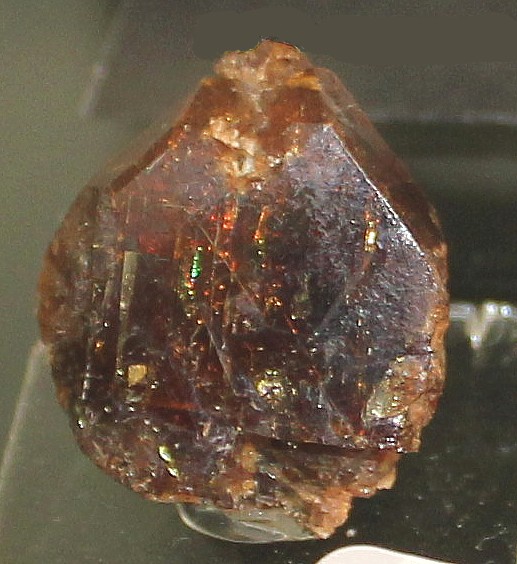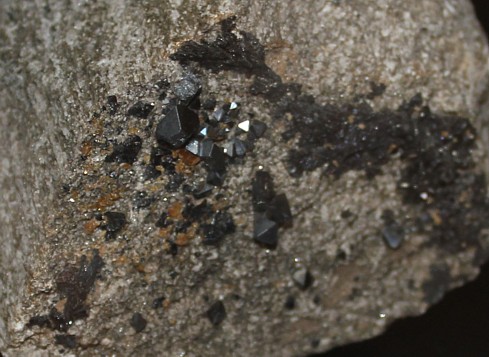|
.
Monazite
Mineral Facts:
Chemical
Formula:
(Ce,La,Pr,Nd,Th,Y)PO4
A phosphate
of cerium and the other rare earth metals. Monazite has been identified in
Cerium, Lanthanium,
Neodymium
and
Praseodymium
rich versions. Cerium dominates in nearly all monazite deposits. It also
normally contains some Thorium and Uranium, as well as some silica.
Colors:
Yellowish
to reddish brown
or green.
Hardness:
5
to 5.5
Hardness is such that the material
easily writes on paper and soils fingers handling the specimen, giving a
greasy feel to the touch.
Density:
5.2 to 5.3
Cleavage:
One distinct cleavage on
100.
Crystallography: Monoclinic
Individual crystals are
rare, but do occur in pegmatites. Typically small, often flattened parallel
to the orthopinacoid. Normally found in granular masses, frequently as sand.
Luster:.
Resinous luster. Translucent to opaque.
Optics:
(Refractive Index):
a=1.7038, y=1.8452 |

Monazite - Crystal form, Pakistan |
|
Composition, Structure and
Associated Minerals:
Monazite is a
comparatively rare mineral occurring
as a minor accessory mineral
in the form of
small grains and crystals scattered through certain
granites,
granitic schists
and pegmatites. It is found in pegmatite veins at many localities,
associated with
quartz
and felspar. In these veins it usually occurs as
fairly large crystals and fragments of a brownish color.
In these primary forms it is a separation on cooling from the granitic
magma.
It is found only in very small percentages in these
rocks. However because it is dense and resists weathering,
when the granites are broken
down into sand by weathering the monazite is freed and
concentrated into commercial quantities in alluvial
stream channels
and sand deposits. Most commercial deposits are found
in
layered beach sands.
Identification
and Diagnostics
The mineral is infusible. Before
the blow pipe it turns gray, and when moistened with H2SO4 it colors the
flame bluish green. Most specimens are strongly radioactive because of the
typical thorium and uranium content. Insoluble in hydrochloric acid.
After fusion with sodium carbonate, dissolve in nitric acid and add solution
to excess of ammonium molybdate solution. A yellow precipitate forms (test
for a phosphate) . Decomposed by heating with concentrated sulfuric acid;
solution after dilution with water and filtering gives with ammonium oxalate
a precipitate of the oxalates of the rare earth metals..
|

Monazite - Brown color |
|
|
Localities
The Although the mineral is fairly widespread in the rocks. it is
concentrated into commercial deposits at only a few places. The
most important of these are in southeastern Brazil, India, Madagascar and
South Africa. The monazite of the Brazilian Cretaceous sediments
was derived from the gneisses, through which the monazite has been proved to
be disseminated. The sands along the river courses of
the interior are also monazitic. Brazilian monazite sand as marketed in
Brazil is stated to contain about 92 percent monazite and 6.2
to 6.4 percent thoria. Another important locality for monazite is the
coast of Travancore in the south of India. Along this coast, between Muttum
and Colachel, monazite occurs abundantly in a naturally concentrated form,
associated with ilmenite and
zircon.
In the US, it has been mined from a belt 20 to 30 miles wide and 150 miles
long extending along the east side of the Appalachian Mountains from North
Carolina into South Carolina. The mineral has also been reported from many
points in ten counties in Idaho. Near Centerville it was found with placer
gold in the heavy mineral concentrates and termed "heavy yellow sand" by the miners. It may be in
sufficient quantity to be of commercial importance at this location.
Industrial Uses of
Monazite
Although it has been eclipsed by
bastnaesite as the principal source of rare earths, Monazite is still an
important rare earth ore mineral.
Monazite sands usually consist of
monazite naturally concentrated with other heavy minerals, such as
magnetite,
rutile, ilmenite, zircon, garnet, xenotime, etc. Monazite is separated
from the valueless sand in which it is found, by washing, and the residues
thus resulting are further concentrated by a magnetic process. This
concentration is effected by electro-magnetic separators, the magnets of
which are adjusted to varying intensities. Magnetite and ilmenite are first
removed, and monazite, usually the most feebly magnetic, last. Rutile,
zircon, and siliceous matter pass into the reject. Using gravity, magnetism
and and electrostatic separation, a nearly pure
monazite product can be produced. The
manufacture of rare earths and thorium chemicals from the separated monazite
is a complicated and purely chemical operation. Methods using both strong
acids (sulfuric) and strong bases (sodium hydroxide) have been employed to
dissolve and separate the different metals present in the monazite.
.Return
to the
Mineral Collectors Information Page |
|


